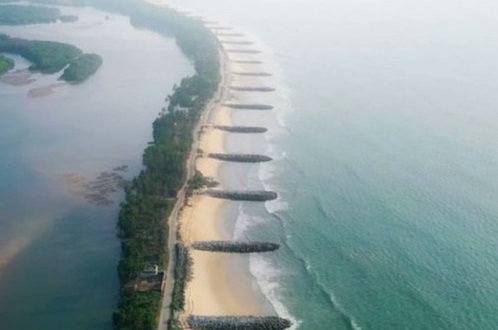
Coastal erosion is the displacement or loss of land caused due to rise in sea level, resulting in strong waves and coastal flooding. There are anthropogenic activities or natural causes that hasten the erosion of the coast. Natural causes of coastal erosion are hydraulic actions, attrition, abrasion, corrosion, and solution (acidic elements of the seawater dissolving rocks containing limestone or chalk). This affects the communities that live along the coast and depend on it for their livelihood. At the same time, the area’s biodiversity, including plant and animal lives, is seriously endangered.
The Indian mainland has 9 coastal states and 2 Union Territories, having 66 coastal districts (2018). A 2018 report published by National Centre for Coastal Research (NCCR) says around 99 sq.km of land along the West Bengal coast alone was lost during 1990-2016. More than 40% of erosion is noticed in four states: West Bengal (63%); Pondicherry (57%); Kerala (45%) and Tamil Nadu (41%). The sea levels swelled by 40 cm in the past century. It is projected to rise by another 60 cm by the next century. As per the IPCC report, a rise of 1 mm per year can inundate about 0.5 m per year.
In response to a question, Dr Jitendra Singh, Union Minister of State (Independent Charge) of the Ministry of Earth Sciences, Minister of State (Independent Charge) of Science & Technology, Minister of State in the Prime Minister’s Office, Minister of State in the Ministry of Personnel, Public Grievance, informed the Lok Sabha on 6 April 2022 that about 34% of India’s 6,907.18-km long coastline was under varying degrees of erosion.
“As per the 6thAssessment Report (AR6) of the Intergovernmental Panel on Climate Change (IPCC), relative to 1995-2014, the global mean sea level is expected to rise by 2100 is 0.28-0.55 m under the very low greenhouse emission scenario (SSP1-1.9), 0.44-0.76 m under the intermediate emission scenario (SSP2-4.5), and 0.98-1.88 under the very high emission scenario (SSP5-8.5),” the Minister informed.

Coastal erosion is the displacement or loss of land caused due to rise in sea level, resulting in strong waves and coastal flooding. There are anthropogenic activities or natural causes that hasten the erosion of the coast. Natural causes of coastal erosion are hydraulic actions, attrition, abrasion, corrosion, and solution (acidic elements of the seawater dissolving rocks containing limestone or chalk). This affects the communities that live along the coast and depend on it for their livelihood. At the same time, the area’s biodiversity, including plant and animal lives, is seriously endangered.
The ice acts like a protective cover over the earth and oceans. White ice reflects the sunlight into space and keeps the planet cooler. Glaciers are the global reservoirs of water that continually melt to contribute water to the entire ecosystem. However, the faster melting of glaciers has significant socio-economic impacts. A massive amount of icy water from the glaciers entering the warmer ocean slows down ocean currents. The other major problems are sea level rise, associated natural hazards, and resource allocation.
Many glaciers worldwide have been melting rapidly since the 1990s, primarily due to human activities. Repeat photography and satellite and aerial photography have provided evidence of glacier loss in shape, size, and volume. A study published in ‘Nature’ (April 2021) has estimated that almost 270 billion tonnes of ice a year were lost during the first two decades of the 21st century. This meltwater produced about a fifth of global sea-level rise.
Since the industrial revolution, the emission of carbon dioxide and other greenhouse gases have raised temperatures globally and especially around the poles. As a result of this, glaciers are rapidly melting. Experts have opined that even if we succeed in curbing the emissions significantly, 95% of the oldest and thickest ice in the Arctic is already gone and over one-third of the world’s remaining glaciers will melt before the year 2100.
As per a study published in Current Science (25 July 2015), in India, the highest percentage of shoreline under erosion is in the Nicobar Islands (88.7%); highest percentage of accreting coastline is for Tamil Nadu (62.3%); whereas Goa has the highest percentage of stable shoreline (52.4%). Researchers have also pointed out that the relentless modification of the coastline due to mounting development activities along the coastal region is to be blamed for severe coastal erosion. The NCCR report points towards human actions like dredging of tidal entrances, constructions of harbours and other structures like jetties, river water regulation works such as the construction of dams, hardening of shorelines with seawalls, beach nourishments, beach sand mining, destruction of mangroves, etc.
As per the article in Nature, about 200 million people reside in areas predicted to fall below the high-tide lines of rising sea levels by the end of the century and more than one billion could face water shortage and food insecurity within the next three decades. Communities must be prepared to be aware of the imminent dangers. All efforts must be taken for reducing the emission of heat-trapping gases in the atmosphere. Individuals can also play a big role. They can be guided on taking steps for reducing emissions simply by introducing some small changes in their daily routine to lower the carbon footprint.
The ongoing coastal clean-up campaign ‘Swachh Sagar, Surakshit Sagar’ (Clean Coast Safe Sea) will sensitise people to keep the Indian coastlines free of litter, waste, and debris. The communities living near the coastline and all the other people must be made aware of how casually dumped non-degradable garbage pollutes the sea and harms marine biodiversity.
India Science Wire
ISW/SM/COASTAL-EROSION/SWACHH SAGAR, SURAKSHIT SAGAR/18/07/2022





